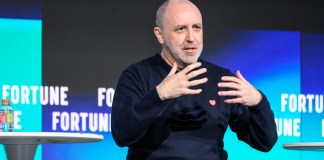A lot is riding on the AI boom, and it isn’t just the stock market surge. AI is being touted as an elixir for a number of serious economic challenges, according to Ruchir Sharma, chair of Rockefeller International.
In a Financial Times column on Sunday, the market veteran pointed out that the “immigration boom-bust cycle” that the U.S. is experiencing now is unprecedented in scale, swinging from a net gain of more than 3 million in 2023 to an expected trickle of just 400,000 this year. The drastic throttling in the labor force could slash U.S. growth potential by more than 20%.
“Yet increasingly the response to this risk, too, is a shrug. AI is going to make human labor less necessary anyway,” Sharma quipped.
Meanwhile, the U.S. debt-to-GDP ratio is already at 100% and expected to continue galloping higher, topping the World War II–era record high in the coming years.
But again, AI could come to the rescue by propelling economic growth enough to stabilize the debt. The global bond market even appears to be pricing in that scenario, Sharma said, pointing to surging yields for Japan, France, and the U.K., even though they have smaller budget deficits than the U.S. does.
“The main reason AI is regarded as a magic fix for so many different threats is that it is expected to deliver a significant boost to productivity growth, especially in the U.S.,” he added.
In addition to the workforce and debt woes, AI could even ease inflation risks, including tariff-driven pressure, by enabling companies to raise wages but still keep prices steady, Sharma said.
The hoped-for benefits of a productivity boom aren’t totally far-fetched. The Congressional Budget Office estimated earlier this year that booting productivity growth by 0.5 percentage points each year for 30 years could make publicly held debt 113% of GDP by 2055, instead of 156%.
And the U.S. has in fact enjoyed more productivity growth in recent years than other developed economies have, stoking further hype among investors that the lead will widen.
America’s AI narrative has helped global investors overcome the shock of President Donald Trump’s trade war and “Liberation Day” tariffs, which triggered a sudden exodus out of U.S. markets. But the money quickly came back, and Sharma said foreigners plowed $290 billion into U.S. stocks in the second quarter and now own 30% of the market.
“In a way, then, America has become one big bet on AI,” he said.
Excluding AI-related stocks, European markets have actually been beating the U.S. this decade, and the outperformance is spreading to other sectors.
“What that suggests is that AI better deliver for the U.S., or its economy and markets will lose the one leg they are now standing on,” Sharma warned.
He’s not the only voice sounding the alarm. Lisa Shalett, chief investment officer for Morgan Stanley Wealth Management, wrote on Sept. 29 that “it’s hard not to still see … a boom driven by a one-note narrative.” Since ChatGPT’s launch, Shalett noted, what she considers “AI data center–ecosystem stocks” have accounted for roughly 75% of S&P 500 returns, 80% of earnings growth, and 90% of capital expenditures growth. “It’s difficult to ignore the market’s reliance on AI capex,” she concluded.
For now, Wall Street seems happy to ride the wave. On Monday, OpenAI’s announcement that it’s taking a stake in chipmaker AMD sparked another stock market rally.
Analysts are also hiking price targets for other hot AI plays like Nvidia as well as the overall S&P 500. And while the recent string of record highs has fueled concerns about a bubble, certain metrics indicate that the AI boom isn’t yet at dotcom-bust levels.
Others still see conditions getting frothier. Evercore ISI analyst Julian Emanuel said in a note on Monday that he now sees 30% odds of the S&P 500 soaring to 9,000 at the end of next year in a “bubble scenario,” up from 25% odds just a few weeks ago. His base case is for the index to reach 7,750 by then, representing a gain of 15% from current levels.
Great Job Jason Ma & the Team @ Fortune | FORTUNE Source link for sharing this story.





